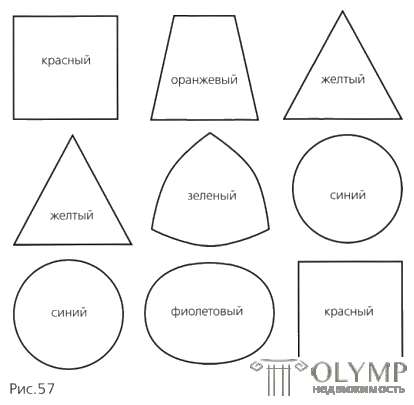
Later, in the section specifically devoted to the theory of color expressiveness, I will try to describe the expressive possibilities of color. However, the form, as well as color, has its “sensual and moral” expressive value. In the pictorial work these expressive qualities of form and color should act synchronously, that is, the form and color should support each other.
As for the three primary colors — red, yellow, and blue — and for the three main forms — the square, the triangle, and the circle — their inherent expressive characteristics must be found.
The square, the main character of which is determined by two horizontal and two vertical intersecting lines of the same length, symbolizes matter, gravity and strict limitation. In Egypt, the square served as the hieroglyph of the word "field". And it is clear why we feel strong tension, if we want to make the straight sides and right angles of the square express movement. All forms built on horizontals and verticals have the character of uvadrachenny forms, including here a cross, a rectangle, a meander and their derivatives.
The square corresponds to the red color as the color of matter. The severity and opacity of red color is consistent with the statics and the heavy shape of the square.
The shape of the triangle arises from three intersecting diagonals. His sharp corners seem militant and aggressive. All forms of a diagonal character, such as diamonds, trapeziums, zigzags, and their derivatives, are listed as triangles. The triangle is a symbol of thought and its weightless character corresponds to a light yellow color.
A circle is a geometric shape that occurs when moving at a constant distance from a certain point located on some surface. In contrast to the heavy, tense feeling of movement that causes a square, movement for a circle is natural, constant, and creates a feeling of rest and relaxation of tension. The circle is a symbol of constantly moving spirituality. In ancient China, the layout of temples was based on a circle, while the palace of the emperor of the earth was built on the basis of square forms. The astrological symbol of the sun is a circle with a point in the center. All curved forms of a circular character, such as an ellipse, oval, wave-like parabolas and their derivatives, are included in the circle. The continuous movement of the circle in the area of color corresponds to blue.
In general, it can be said that a square is a symbol of motionless matter, a triangle radiating itself in all directions is a sign of thought, and a circle is an eternal movement of the spirit.
If for flowers of the second order try to find the corresponding forms, then for orange - it will be a trapezoid, for green - a spherical triangle and for purple - an ellipse (Fig. 57).
The subordination of a particular color to its corresponding form implies a certain parallelism. Where color and form are matched in their expressiveness, their effect on the viewer is doubled. The picture, the impact of which is determined mainly by color, should be based on the subordination of form to color, and the picture in which the artist attaches the main importance to form should, in its color scheme, come from form.

The cubists paid special attention to the problems of the form and therefore were reduced to color, reducing the number of colors they used in their paintings. Expressionists and futurists equally showed interest in both form and color. The Impressionists and Tashists preferred form to color.
What has been said about the subjective attitude towards color also applies to form. In accordance with his constitution, each person has an inherent preference for certain forms. And it is no coincidence that graphologists thoroughly investigate the connection between subjective forms of handwriting and the person who wrote. However, only some subjective factors can manifest themselves in a handwritten font.
In ancient China, they admired fonts that had a subjectively original character. But most of all the fonts in which originality and harmony were balanced were most appreciated.
The same was appreciated in ink drawings. Liang Kai and other great masters took the next step. The interest in “originality and individuality of style” gave way to the search for the absolute and the solution of each topic based on the general means of expression. The nature of the letter in Liang Kai is so different that it takes great effort to determine its authorship. The subjective nature of the form was overcome by him in the name of the highest objective truth.
In the art of painting there are many objectively determined possibilities. They open both in the construction of space, and in the distribution of accents, and in the free choice of forms and surfaces with their color and texture.
In European painting, objectivity in color and form was sought by Matthias Grunewald. While Conrad Witz and El Greco were extremely objective, primarily in color, but extremely subjective in the transfer of forms. Georges de la Tour worked subjectively with color and form, as did Van Gogh, who preferred formal and color subjectivity.
Что бы оставить комментарий войдите
Комментарии (0)